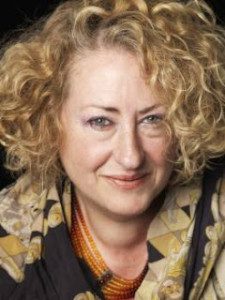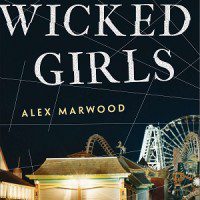The mystery novel The Wicked Girls is a horrifying book, full of murder, betrayal, and intrigue—but the real source of the horror will surprise you. The novel switches between the present and one day in 1986—when two eleven-year-old girls meet for the first time and murder another little girl only hours later. After spending their childhoods in prison, Jade and Bel have grown up to become Kirsty, a freelance journalist with a husband and two children, and Amber, a cleaner on the nightshift at Funnland, an amusement park in the south England seaside town of Whitmouth. As the novel begins, murders of young women have begun popping up in the town. When Amber discovers a body in Funnland’s infinite hall of mirrors during her shift—the third local murder in a little over a year—the media furor sets in, and Kirsty is deployed Whitmouth. Essentially dead to each other since they were children—and forbidden by their parole terms to be in contact with one another—Kirsty and Amber are left to tiptoe around each other, the murders, their families, and the public eye. Rather than the mystery of the serial killer, Kirsty and Amber’s struggles to keep themselves and their families safe from the past functions as the main drama of the book.
The Wicked Girls is the first novel of pseudonymous author Alex Marwood, an experienced British journalist. As such, the novel holds a rapt gaze on the circus that is British tabloid culture: As a freelance reporter for a daily London newspaper, Kirsty trades gossip with the other reporters, opines on each outlet’s bloodthirstiness (as well as the high-mindedness of The Guardian), and is greeted with contempt by the locals in turn. The tension between truth and appearances is on full display here; just as Kirsty and Amber were harangued by the media as children, so does Kirsty visit the same wrath upon others. The media’s obsession with scandal (without patience for context) is also what allows more sinister, entrenched cultural mores to develop: this is a novel about the background behind the spectacle.
While the novel is awash in violence, its strength lies in how it prioritizes its terror; The Wicked Girls highlights the scariest organic crimes without hiding the atomic ones. Kirsty and Amber are criminals, but the story of the murder they committed—spilled out slowly in non-chronological bits—is far from the scariest or most shocking part of the novel. What does surprise, when their childhood murder is finally revealed, is its very banality. Even the reveal of the Whitmouth serial killer’s identity pales in comparison to the casual brutality of the local men. The casual victim-blaming, womanizing, and stalking done by other people is what truly drives the novel’s sense of unease and distrust.

While not the serial murderer, Martin Bagshawe—a young Whitmouth local with an obsessive personality and a predilection for stalking—is the novel’s horrific villain. Never quite at the center of the action for most of the book, Martin creeps around its edges, filtering the narrative’s events through his own self-interested delusions. The novel opens with Martin lying around his apartment one night, texting Jackie, his latest obsession, every few hours. The habituality of his frustration is made clear: “He feels a swell of familiar rage at the way she has just cut him off. No response, no contact; just empty silence, day after day. Is she even thinking about him? He’s left it three hours, but he can’t stand the waiting any longer.” He hears a “hen party” outside, a drunken bachelorette party, and loneliness intensifies his rage. With the utmost ease, Martin tangles together his impressions of Jackie with those of the drunk women in the street—and, later, with prostitutes, other local women, and Kirsty—until all he feels is a blind resentment of women, all for various, but not totally dissimilar, reasons.
And while Martin is the book’s nexus of misogyny, the plot is chockfull of local officials who demand young women to remain alert and sober, long-time partner and hero figures who are revealed to be womanizers, and all the men on the sidelines who laugh about it.
The Slovenian philosopher Slavoj Žižek has argued of the films Y Tu Mamá También and Children of Men that the faint background just behind the protagonists is the true focus: “If you look at the thing too directly, the oppressive social dimension, you don’t see it. You can see it in an oblique way only if it remains in the background.” The swirling mass of perceptions and happenings behind the main drama of Kirsty and Amber’s past crime is what makes The Wicked Girls more than a plot-driven mystery novel. (Not that it isn’t also that; Marwood sacrifices no speed, no engaging details or cliffhangers for the sake of the book’s spiky undercurrent). It is from this society—one that villainizes isolated, accidental incidents rather than constant and calculated cruelty—that terror truly emerges.
Kirsty and Amber are not important because of Whitmouth’s serial murders, or even because of the murder they committed as children. Through their own struggles to survive, protect their unknowing families, and reconcile themselves with their pasts, the two women lay bare the fallacy at the heart of anti-heroism. The values praised in some as heroic, courageous or simply notable are just referred to as “living” by others. The Wicked Girls melds the mundane and the spectacular into two honest characters—ordinary, hardworking women, normal in every way but their horrific pasts. As Michel Houellebecq notes in his novel The Elementary Particles, “Historically, such human beings have existed. Human beings who have worked—worked hard—all their lives with no motive other than love and devotion, who have literally given their lives for others, out of love and devotion…. In general, such human beings are generally women.” Marwood’s protagonists perfectly embody the horror at the heart of everyday life, the position of women in society, and the constant fear that comes with having a family.




